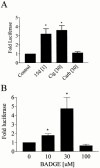Bisphenol A diglycidyl ether (BADGE) is a PPARgamma agonist in an ECV304 cell line
- PMID: 11030710
- PMCID: PMC1572386
- DOI: 10.1038/sj.bjp.0703628
Bisphenol A diglycidyl ether (BADGE) is a PPARgamma agonist in an ECV304 cell line
Abstract
Peroxisome proliferator activated receptors (PPAR)s are nuclear transcription factors of the steroid receptor super-family. One member, PPARgamma, a critical transcription factor in adipogenesis, is expressed in ECV304 cells, and when activated participates in the induction of cell death by apoptosis. Here we describe a clone of ECV304 cells, ECV-ACO.Luc, which stably expresses a reporter gene for PPAR activation. ECV-ACO.Luc respond to the PPARgamma agonists, 15-deoxy-Delta(12,14) PGJ(2), and ciglitizone, by inducing luciferase expression. Furthermore, using ECV-ACO.Luc, we demonstrate that a newly described PPARgamma antagonist, bisphenol A diglycidyl ether (BADGE) has agonist activities. Similar to 15-deoxy-Delta(12,14) PGJ(2), BADGE induces PPARgamma activation, nuclear localization of the receptor, and induces cell death.
Figures



Similar articles
-
Bisphenol a diglycidyl ether (BADGE) suppresses tumor necrosis factor-alpha production as a PPARgamma agonist in the murine macrophage-like cell line, RAW 264.7.Cell Biol Int. 2002;26(3):235-41. doi: 10.1006/cbir.2001.0838. Cell Biol Int. 2002. PMID: 11991651
-
Simultaneous, bidirectional inhibitory crosstalk between PPAR and STAT5b.Toxicol Appl Pharmacol. 2004 Sep 15;199(3):275-84. doi: 10.1016/j.taap.2003.12.020. Toxicol Appl Pharmacol. 2004. PMID: 15364543
-
Regulation of the growth arrest and DNA damage-inducible gene 45 (GADD45) by peroxisome proliferator-activated receptor gamma in vascular smooth muscle cells.Circ Res. 2003 Aug 22;93(4):e38-47. doi: 10.1161/01.RES.0000088344.15288.E6. Epub 2003 Jul 24. Circ Res. 2003. PMID: 12881480
-
Anti-inflammatory actions of peroxisome proliferator-activated receptor gamma agonists in Alzheimer's disease.Neurobiol Aging. 2001 Nov-Dec;22(6):937-44. doi: 10.1016/s0197-4580(01)00296-2. Neurobiol Aging. 2001. PMID: 11755002 Review.
-
Peroxisome proliferator-activated receptor gamma agonists: potential use for treating chronic inflammatory diseases.Arthritis Rheum. 2002 Mar;46(3):598-605. doi: 10.1002/art.10052. Arthritis Rheum. 2002. PMID: 11920394 Review. No abstract available.
Cited by
-
Anti-obesity effects of Lysimachia foenum-graecum characterized by decreased adipogenesis and regulated lipid metabolism.Exp Mol Med. 2011 Apr 30;43(4):205-15. doi: 10.3858/emm.2011.43.4.025. Exp Mol Med. 2011. PMID: 21389766 Free PMC article.
-
PPARgamma Inhibitors as Novel Tubulin-Targeting Agents.PPAR Res. 2008;2008:785405. doi: 10.1155/2008/785405. PPAR Res. 2008. PMID: 18509498 Free PMC article.
-
Emerging PPARγ-Independent Role of PPARγ Ligands in Lung Diseases.PPAR Res. 2012;2012:705352. doi: 10.1155/2012/705352. Epub 2012 Jun 18. PPAR Res. 2012. PMID: 22778711 Free PMC article.
-
Bisphenol A: Perinatal exposure and body weight.Mol Cell Endocrinol. 2009 May 25;304(1-2):55-62. doi: 10.1016/j.mce.2009.02.023. Epub 2009 Mar 9. Mol Cell Endocrinol. 2009. PMID: 19433248 Free PMC article. Review.
-
Bisphenol A diglycidyl ether induces adipogenic differentiation of multipotent stromal stem cells through a peroxisome proliferator-activated receptor gamma-independent mechanism.Environ Health Perspect. 2012 Jul;120(7):984-9. doi: 10.1289/ehp.1205063. Epub 2012 May 25. Environ Health Perspect. 2012. PMID: 22763116 Free PMC article.
References
-
- BISHOP-BAILEY D., HLA T. Endothelial cell apoptosis induced by the peroxisome proliferator-activated receptor (PPAR) ligand 15-deoxy-Δ12,14 prostaglandin J2. J. Biol. Chem. 1999;274:17042–17048. - PubMed
-
- BRADFORD M.M. A rapid and sensitive method for the quantitation of microgram quantities of protein utilizing the principle of protein-dye binding. Anal. Biochem. 1976;7:248–254. - PubMed
-
- BRUN R.P., TONTONOZ P., FORMAN B.M., ELLIS R., CHEN J., EVANS R.M., SPIEGELMAN B.M. Differential activation of adipogenesis by multiple PPAR isoforms. Genes Dev. 1996;10:974–984. - PubMed
-
- FORMAN B.M., EVANS R.M. Nuclear hormone receptors activate direct, inverted, and everted repeats. Ann. N. Y. Acad. Sci. 1995;12:29–37. - PubMed
Publication types
MeSH terms
Substances
LinkOut - more resources
Full Text Sources
Molecular Biology Databases

